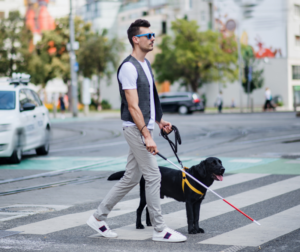
Unlocking The Secrets Of Your Dogs Intelligence
Dogs play such a huge role in the lives of their families. We talk to them, ask them questions, greet them, and address them as people. Just as we communicate with them, they communicate with us through dog body language and facial expressions. But how much do we really understand about what goes on inside their minds?
Recent studies in canine psychology offer us a window into dogs’ complex emotional and cognitive world. Your dog is smarter than you think!
Exploring Your Dogs Brain
Dogs have brains designed for sophisticated processing, allowing them to interpret information from their environment, communicate with humans, and solve problems. While their brains are smaller in size compared to humans, the part that controls thinking and problem-solving is incredibly well-developed.
Dogs can process information, very similar to humans. This allows them to understand a surprising amount of human language. It’s been found that the average dog can learn and understand between 165 and 250 words and phrases. You see, what did I tell you? Your dog is really smart! That means your dog can understand many commands, names, and simple sentences.
Dogs don’t just listen. They actively solve problems and make decisions based on what they hear. This ability is rooted in specific areas of their brain that focus on memory, learning, and decision-making.

Chances are you’ve seen videos on social media of dogs doing amazing things, like opening a door to allow a cat in the home and then closing the door. Or getting someone a beer out of the fridge and delivering it to them sitting on the couch. There’s no doubt dogs use their cognitive skills to navigate the world around them.
It’s amazing how well dogs can comprehend human cues, ranging from spoken instructions to subtle gestures. I remember when I would prepared my lunch for work, making a sandwhich containing lettuce.

My girl Lucy understood the body language, of me standing at the kitchen counter and hearing the sound of breaking apart lettuce, that she was getting a few lettuce bits for a treat. She just knew. She knew many things! This skill is a testament to the deep bond between dogs and humans, developed over millennia of companionship.
Dogs have an impressive memory. They can remember not only commands and routines but also people, places, and experiences for a long time. Their ability to learn by association helps them connect cues and outcomes. This foundation is helpful for both basic training and complex behavior modification.
Exploring the World with a Dogs Perspective
Have you ever wondered how your dog sees the world? To really understand the psychology of dogs, you have to consider their sensory perception. A dog’s sensory perception is very different from a human’s. Dogs experience the world primarily through their sense of smell, followed by hearing and sight, each offering a unique perspective on their environment.
The Dogs Power of Smell

A dog’s sense of smell is its most powerful sensory tool. Smell allows dogs to detect scents we can’t even begin to perceive. This incredible ability informs much of their emotional and cognitive world, from identifying family members to sensing changes in mood or health.
Research has shown that dogs can be trained to sniff out certain diseases and medical conditions in people. For instance, some dogs can detect the slight changes in scent produced by cancer cells, even in the early stages of the disease. Similarly, dogs have been trained to alert their diabetic owners to drops in blood sugar levels by sensing the change in their body odor or breath.
Dogs Sense of Hearing and Communication
Dogs have a wide range of hearing frequencies, enabling them to hear sounds beyond human capability. This acute sense of hearing is critical in communication with humans and other dogs and influences their emotional well-being.
Dogs can detect the slightest variations in the tone and pitch of a person’s voice. This allows them to understand nuanced commands from their human. This sensitivity also allows them to comprehend the emotional state of their owners through voice changes, enhancing their role as empathetic companions.
Dogs can hear approaching threats, such as predators, well before humans, providing an early warning system. This ability also aids in their navigation and hunting, as they can hear the movements of prey or find members of their pack through soft sounds.
They can even differentiate between various barks, growls, and whines of their canine peers, allowing them to respond appropriately to invitations to play, warnings of danger, or signals of distress.
The Dogs Visual Perception
Dogs rely quite a bit on their sense of smell and hearing, but their vision also plays a vital part in interpreting their surroundings. Although dogs’ vision is not as sharp or color-rich as human sight, it is designed to cater to their needs.
Dogs are susceptible to moving objects, a trait inherited from their ancestors who relied on spotting and chasing prey. They are adapted for low-light conditions, allowing advantages for early morning or late evening activities.
This does come at the expense of visual acuity. What humans can see clearly at 75 feet, a dog might need to be 20 feet away to see with the same clarity. Despite these differences, dogs have a wider field of view than humans, which aids in detecting threats and opportunities around them. The drawback is reduced depth perception.
Understanding Dog Emotional Intelligence
I think we can all agree that dogs experience a wide range of emotions. From the wagging tail of a happy pup to the low whine of a dog missing its owner, the emotional spectrum of dogs is vast. Let’s explore some common emotions dogs experience.
Joy and Affection

Everybody knows dogs express joy and affection. Have you ever seen the joy of a dog when a family member returns home from an outing? It’s as if the dog thought you were never coming back! These behaviors are not just reflexive responses but are rooted in deep emotional connections with their human companions.
Anxiety and Fear
The emotions of fear and anxiety are common in dogs. Dogs can experience fear and anxiety due to various factors, such as unfamiliar surroundings, loud noises, or separation anxiety. I have seen dogs fearful of thunder and lightning run under a bed, fearing the end of the world.
Empathy and Compassion
Dogs have been found to express empathy. Empathy in response to the emotional states of their human companions and even other dogs. Dogs comforting their owners or showing concern for a distressed animal friend offer poignant examples of canine compassion.
Nurturing the Mind: Dog Mental Health and Well-being
Just as with humans, maintaining mental health is essential for dogs. This includes providing them with stimulation, socialization, and the opportunity to engage in natural behaviors.
Mental Stimulation
Keeping your dog’s mind active and engaged helps prevent boredom and anxiety, contributing to overall mental health. Interactive toys, training sessions, and new experiences can provide valuable mental stimulation. Consider interactive toys such as these to enhance your dog’s life and mental health:
 Wickedbone Smart Bone: The Wickedbone is designed to keep your puppy engaged, with the ability to customize the toy’s responsiveness through a smartphone app.
Wickedbone Smart Bone: The Wickedbone is designed to keep your puppy engaged, with the ability to customize the toy’s responsiveness through a smartphone app.  PetSafe Busy Buddy Tug-A-Jug Meal-Dispensing Dog Toy: The Tug-A-Jug dispenses treats or meals as your puppy interacts with it, rewarding their effort and keeping them engaged for extended periods. The toy’s unique design stimulates your puppy’s senses and encourages active play.
PetSafe Busy Buddy Tug-A-Jug Meal-Dispensing Dog Toy: The Tug-A-Jug dispenses treats or meals as your puppy interacts with it, rewarding their effort and keeping them engaged for extended periods. The toy’s unique design stimulates your puppy’s senses and encourages active play.  Outward Hound Hide A Squirrel Puzzle Toy: Outward Hound Hide A Squirrel Puzzle Toy was designed to challenge your puppy’s problem-solving skills. The game involves hiding plush squirrels inside a soft tree trunk and encouraging your puppy to find them.
Outward Hound Hide A Squirrel Puzzle Toy: Outward Hound Hide A Squirrel Puzzle Toy was designed to challenge your puppy’s problem-solving skills. The game involves hiding plush squirrels inside a soft tree trunk and encouraging your puppy to find them.
Socialization and Bonding
Having social interactions with humans and other dogs is extremely important for emotional development and overall well-being. Positive social experiences help dogs learn appropriate behaviors and form secure emotional attachments. For more insights, Essential Guide on Happy Dog Interactions
Decoding Dog Facial Expressions

Dogs communicate much of what they feel through their faces. A relaxed dog with a slightly open mouth and soft eyes is generally content, while a dog with a furrowed brow, pinned-back ears, and a hard stare might feel anxious or aggressive. Recognizing these subtle cues can significantly enhance our understanding of our pets’ emotional states.
Happiness and Relaxation
A happy or relaxed dog often has a ‘soft’ facial expression, relaxed ears, slightly squinted eyes, and possibly a panting mouth that looks like a smile. This expression indicates they’re comfortable and at ease with their surroundings.
Fear and Anxiety
Fearful or anxious dogs might display a combination of wide eyes (whale eye), flattened ears, and a tense mouth. Some may even show the whites of their eyes, indicating stress or fear. Recognizing signs early can help prevent a fearful response from escalating.
Aggression and Warning
An aggressive or warning expression might include bared teeth, a wrinkled nose, an intense stare, and ears pinned back or pointed forwards. Such expressions serve as a clear signal that the dog is feeling threatened and may react if provoked.
Interpreting Dog Body Language
Dogs use their entire bodies to communicate, from the tip of their tail to the position of their fur.
The Tail Tells
A wagging tail doesn’t always mean a dog is happy. The speed and direction of the wag, combined with body posture, can indicate everything from joy to nervousness or even aggression. A relaxed, wagging tail generally means happiness, while a stiff, slow-moving tail can signal tension or uncertainty.
Posture and Positioning
A dog’s posture can reveal a lot about its mood and intentions. A dog standing tall with its weight forward might display dominance or aggression, while a dog with its body lowered or crouched shows submission or fear.
Movement and Gestures

We’ve all seen a dog’s quirky head tilt when we talk to them and they’re trying their hardest to understand. The head tilt is more than just a cute dog behavior; it’s a complex signal reflecting their intelligence and emotional depth.
- Hearing Enhancement is a key reason dogs tilt their heads, allowing them to adjust their ear canals for better sound localization.
- Engagement: head tilt is a method of showing they’re actively listening and participating in their interactions with humans.
- Through Empathy, this gesture indicates they’re attuned to our emotions and communication cues.
- Lastly, a head tilt often signifies Curiosity, as dogs try to understand new or puzzling stimuli. This simple action highlights their sophisticated cognitive and emotional capabilities.

Play bows, where a dog lowers its front end while keeping its rear end up, signal a desire to play. Conversely, a dog that turns its body away or avoids eye contact might indicate discomfort or a desire to avoid confrontation.
Nurturing the Mind: Dog Mental Health and Well-being
By incorporating this knowledge of dog facial expressions and body language into your daily interactions with your dog, you can make a big difference in their mental health and overall happiness. Catching early signs of stress or anxiety in your dog lets you step in quickly, helping to avoid any future problems. Also when you praise their relaxed or joyful expressions and postures you’re promoting good behavior as well as strengthening the bond you share with your furry friend.
Interactive play, training sessions, and regular, compassionate communication can all benefit from an informed understanding of canine psychology. By paying close attention to our dogs’ many ways of expressing themselves, we can create a deeper, more meaningful relationship with them.
So in completing this journey of exploring dog intelligence, emotions and more, it’s become clear that your furry friend is much more than a pet. They’re full of advanced cognitive abilities and complex emotions. Our furry friends are indeed Super Dogs. Their extraordinary sense of smell can detect even the slightest changes in your health, while their sharp hearing picks up on your every mood. Through their body language, they communicate with us and the world around them. Give your Super Dog – hugs and kisses and an extra treat for me!
This article may contain affiliate links. As an Amazon Associate, I earn from qualifying purchases.